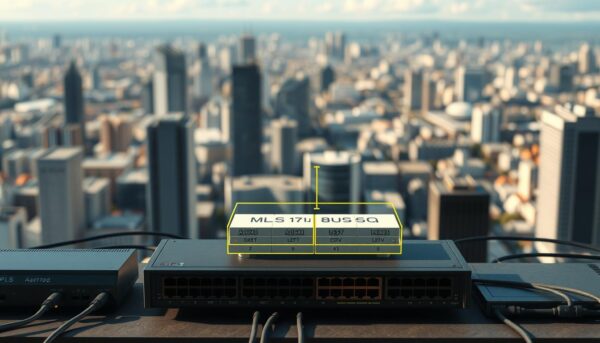✅ Last checked on
Ever wonder how your data zips across the internet? It’s thanks to Multiprotocol Label Switching (MPLS). This tech makes networks more efficient and fast.
MPLS uses labels to quickly move data through networks. This method is faster than traditional IP routing. It’s great for applications like voice and video. As businesses need fast, reliable connections, MPLS is key.
MPLS Traffic Engineering (TE) makes networks even better. It’s about smart routing, not just speed. MPLS TE keeps networks running smoothly, even with many remote offices and cloud apps.
While MPLS boosts bandwidth and user experience, it’s complex and costly. Cloud adoption is growing, making MPLS less suitable. SD-WAN and SASE are emerging as cost-effective alternatives.
Key Takeaways
- MPLS uses label-based forwarding to enhance network efficiency
- MPLS Traffic Engineering optimizes resource utilization and performance
- It’s beneficial for organizations with many remote offices
- MPLS improves bandwidth and application performance
- Emerging technologies like SD-WAN offer alternatives to traditional MPLS
- MPLS is evolving to meet cloud-centric network demands
Understanding MPLS Architecture
MPLS architecture is at the heart of today’s networks, combining Layer 2 and Layer 3 features. Introduced by the Internet Engineering Task Force in 2001, it changed how data moves in private Wide Area Networks. Let’s dive into what makes MPLS a key player in network optimization.
Core Components and Label Switching
MPLS Label Switching has key parts that make data flow smoother. Label Switching Routers (LSRs) and Label Edge Routers (LERs) form paths for data. These paths let packets with similar needs travel together, making routing more efficient.
By avoiding the need to look up complex routing tables, MPLS speeds up data transfer.

MPLS Header Structure and Functionality
The MPLS header is a 32-bit field that greatly improves network performance. It has:
- 20-bit label for routing
- 3-bit Experimental field
- 1-bit label stack indicator
- 8-bit Time-To-Live (TTL) field
This design lets MPLS use up to 1,048,576 labels. This supports a wide range of network setups in the MPLS core network.
Label Distribution Protocols
MPLS uses different protocols to share labels across the network. The main ones are:
- Label Distribution Protocol (LDP)
- Resource Reservation Protocol with Traffic Engineering (RSVP-TE)
- Border Gateway Protocol (BGP)
- Segment Routing
These protocols are vital for setting up and keeping LSPs. They ensure data moves smoothly through the MPLS core network.
Benefits of MPLS in Modern Networks
MPLS Service Providers bring many benefits to modern networks. They help improve network performance and efficiency. Let’s look at the main advantages that make MPLS a top choice for businesses.
MPLS is great at using bandwidth efficiently. It reduces network congestion, making data transmission smooth. It also cuts down on packet loss, leading to more reliable network performance.
MPLS QoS features let you prioritize traffic based on importance. This is key for businesses that need fast, reliable apps like voice and video. By setting different bandwidth levels for different data types, MPLS ensures critical apps get the best service.
Security is another big plus of MPLS. It creates a safe space for data, which is vital for sensitive apps. MPLS supports VPNs and traffic separation, boosting network security. But, it’s important to note that MPLS doesn’t use end-to-end encryption, which can leave it open to some cyber threats.
MPLS makes network management simpler, allowing for easier scaling and upkeep. Businesses can only pay for the bandwidth they use, making MPLS scalable. This is super helpful for growing companies or those with changing bandwidth needs.
| MPLS Feature | Benefit |
|---|---|
| Bandwidth Optimization | Reduces network congestion |
| QoS Capabilities | Prioritizes critical traffic |
| Security Features | Supports VPNs and traffic isolation |
| Scalability | Allows flexible bandwidth provisioning |
The managed MPLS market is set to grow at a CAGR of 6.73% until 2027. This shows MPLS is still a strong choice for improving network performance and ensuring reliable connections as businesses grow.
MPLS Traffic Engineering Fundamentals
MPLS Traffic Engineering (TE) is key in the MPLS Architecture. It boosts network performance and efficiency. It lets network engineers adjust traffic flows to cut down on congestion and improve performance.
Constraint-based Routing
MPLS Traffic Engineering uses constraint-based routing. It finds paths based on specific needs. This method looks at bandwidth and policies, not just the shortest path.
Path Computation and Selection
Path computation in MPLS TE relies on advanced link-state IGPs. These protocols share network resource info. This helps make smart choices for data paths.

Resource Reservation Protocols
MPLS TE uses RSVP-TE for resource reservation. It sets up and keeps traffic-engineered paths. This ensures network resources are used well, boosting performance.
Quality of Service Integration
MPLS TE also integrates Quality of Service (QoS). It prioritizes and protects important traffic. This makes data transmission secure and efficient, bettering the user experience.
| MPLS TE Feature | Benefit |
|---|---|
| Dynamic traffic flow adjustment | Reduced congestion, improved performance |
| Class-based Tunnel Selection | Better resource utilization, increased scalability |
| Tunnel-based admission control | Enhanced bandwidth utilization, increased capacity |
| QoS integration | Prioritized traffic, improved reliability |
Using MPLS Traffic Engineering helps cut down on delays and inefficiencies. It optimizes link use and saves costs by avoiding bandwidth waste.
Network Performance Optimization with MPLS
MPLS Traffic Engineering is key to better network performance. It uses advanced methods to make networks more efficient and reliable.
Bandwidth Management and Allocation
MPLS lets you adjust bandwidth for different traffic types. This ensures important apps get the resources they need. With MPLS QoS, businesses can ensure low-latency for apps like voice and video.
Load Balancing Techniques
MPLS helps spread traffic across different routes. This makes better use of bandwidth. By using multiple paths, networks avoid getting congested.
Traffic Flow Analysis and Control
Network managers use MPLS to watch and adjust traffic. This keeps networks running smoothly. Tools like Route Optimization and Analysis (ROA) help fix problems fast.
- ROA gives real-time and past details for network services
- It manages BGP security risks
- Telemetry monitoring shows latency at each step
By combining routing, traffic, and analytics, networks get better. This shift from fixing problems to preventing them saves money and makes customers happier.
MPLS Security and Reliability Features
MPLS VPNs are very secure and reliable for business networks. They keep unauthorized access out, letting only approved devices in. MPLS service providers use many security tools, like packet filters, firewalls, and intrusion detection systems.
The MPLS header has a 20-bit label for fast forwarding and a 3-bit field for QoS. This setup helps in quick routing and keeps service quality high. MPLS networks are secure without slowing down data, as they don’t encrypt at every point.
MPLS networks use Access Control Lists at the domain edge to only let trusted devices in. Firewalls at each node block unauthorized packets. For extra security, end-to-end VPN tunnels are set up between Provider Edge and Customer Edge routers.
MPLS networks are also very reliable. They support many services over one path, making them flexible. They use hardware-based switching for faster performance, which is great for VoIP and streaming.
MPLS service providers use Intrusion Detection and Prevention Systems for constant protection. These systems check packets going in and out, spotting unusual traffic and hidden attacks. This way, they keep the network safe and services running smoothly.
Conclusion
MPLS has changed how we manage network traffic, helping both service providers and big companies. It makes routing faster and data transmission quicker. This is because MPLS uses set paths and labels packets efficiently.
It works well across different layers of the OSI model. This makes it very flexible in designing networks.
The advantages of MPLS are obvious. It offers low latency, little jitter, and ensures packets are delivered on time. This is great for applications that need real-time data and big networks with thousands of nodes.
For service providers, MPLS is a big win. It allows them to manage traffic, set quality of service, and create secure VPNs. This meets the needs of many clients.
But, as more businesses move to the cloud and remote work grows, things are changing. MPLS is still key for many networks. But, its high cost and limited connectivity are making some look at other options like SASE.
When planning your network, it’s important to think about MPLS and new technologies. This will help you build a network that’s efficient, scalable, and reliable for the future.